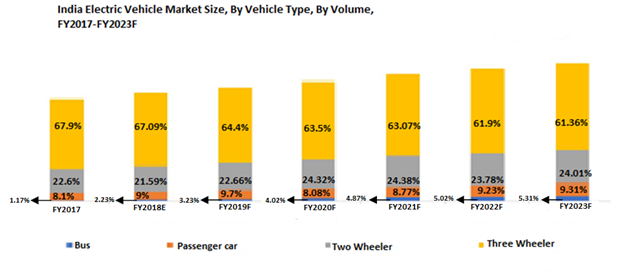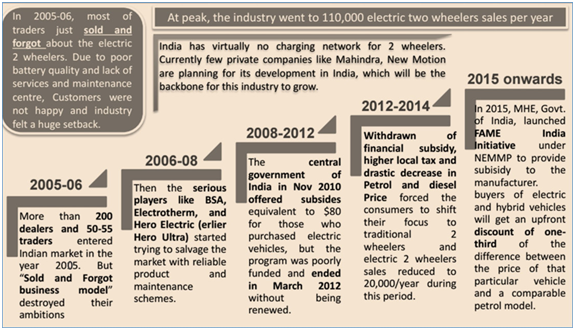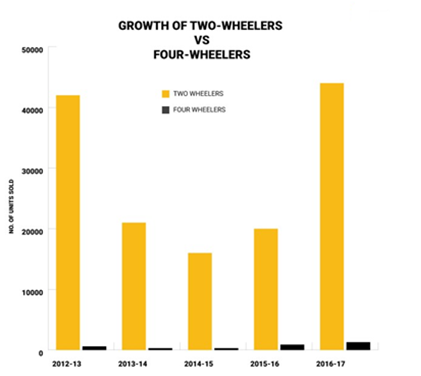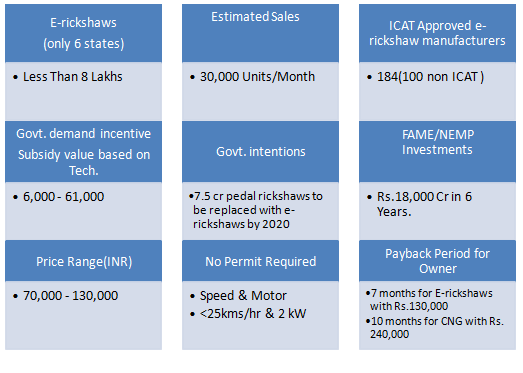Last Updated: February 2020 by Narasimhan Santhanam
This pos![]() t is a part of EV Next’s EV Perspectives.
t is a part of EV Next’s EV Perspectives.
EV Next, a division of EAI, is a leading market intelligence & strategic consulting firm for the Indian e-mobility sector.
Get to know about 1000+ EV innovations from EVI2: Electric Vehicle Innovation Intelligence from EVNext
Introduction
India’s electric vehicle industry is still at its nascence when compared with other international markets such as US, China & Europe etc. China, being the leader holds nearly 50% share of the global electric vehicle market with India accounting for just a share of 0.1%.
Net Zero by Narsi
Insights and interactions on climate action by Narasimhan Santhanam, Director - EAI
View full playlistHowever, a phase change is definitely anticipated for India’s EV industry with major thrust given by the government. To boost the manufacturing of hybrid and electric vehicles in India, the FAME India scheme was launched by the central government in 2015, which targets to achieve production of close to 7 Million EVs by 2020.
Like China, however, India is also planning to spend largely on subsidizing local companies, pushing them at the forefront of electric mobility technologies. But the best part of the FAME scheme is that it is weighted more towards the consumer incentives rather than incentivizing the R&D, which makes sense, as the country stands to gain from the technological advances already made globally.
The Union Budget for FY 2017-18 had allocated INR 795 crore for developing EVs. India has in its hands a lifetime opportunity to make a remarkable contribution towards a sustainable future. With over 3 million passenger cars sold in the previous fiscal 2016-17, the Indian passenger car segment is expected to scale new heights in the near term with EV in a picture.
In 2018, a bit more than 2/3rd of the total market of electric vehicles in India is dominated by electric three wheelers – e-rickshaws and e-autorickshaws. The dominance of three wheelers in the Indian market is set to continue until at least 2023. While estimates suggest that their total share of market (by volume) would have come down to about 60% (from almost 70% in 2018), they will still form the single largest category of EVs in India. This is mainly owing to the strict pollution mandates in regions such as NCR where e-rickshaws dominate.
The second largest category in terms of market volumes (both now and until at least 2023) would be, not surprisingly, electric two wheelers, mainly electric scooters, which is expected to hold on to its overall market share of about 25% from 2018 until 2023.
Indian Electric 4 Wheeler Market
The Indian car market is the world’s fastest growing based on estimates in 2018 that sales could expand dramatically from 4 million vehicles sales in 2017 to 10 million by 2030.
In the electric vehicle segment, Society of Manufacturers of Electric Vehicles (SMEV) stated that as of 2017, Gujarat, West Bengal, Uttar Pradesh, Rajasthan and Maharashtra are the top five states to retail electric vehicles in India.
The data from a survey conducted in 2017 revealed that Gujarat topped the list by retailing 4,330 electric vehicles. West Bengal was in the second position with a sales figure of 2,846 EVs. Uttar Pradesh, Rajasthan and Maharashtra occupied the next three spots with a sales figure of 2,467, 2,388 and 1,926 units respectively.
SMEV also stated that apart from the states mentioned above, the Indian electric vehicle (EV) industry had seen sales growth of 37.5 percent in FY2015-16. Total EV sales for the fiscal stood at 25,000 units (21,000 two-wheelers and 4,000 four-wheelers) as compared to 16,000 EVs sold during 2014-15.
The 2015-16 EV sales volume, though, was still way behind the peak of 85,000-100,000 units during 2011-12 and paled into insignificance when compared to overall sales of over 2.6 million conventionally fuelled vehicles per annum in the country.
While expressing happiness at rising numbers of EV sales, the Society of Manufacturers of Electric Vehicles (SMEV) pointed out that the ambitious target of having 5-6 million EVs by the year 2020 on Indian roads as visualized in the National Electric Mobility Mission Plan (NEMMP) 2020 as well as FAME (Faster Adoption and Manufacturing of Hybrid & Electric Vehicles) would be tough to achieve unless ground level infrastructural deficiencies are removed and credit facilities eased for buying green vehicles.
The study also revealed that out of all electric vehicles sold in India during 2016-17, 92 percent accounted for two and three wheelers and only eight percent four-wheelers were sold in the country. Another surprising fact was that the national capital Delhi, which is hit by the worst of pollution had slipped from the first position to seventh with only 1,072 electric vehicles sold. This shows the reason behind the increase in carbon emission in the capital city.
Current and Future Transportation Trends – Electric Car
The growth of energy storage is increasing exponentially compared to non-storage energy systems, and the increase of the energy storage system is mainly due to the growth of the transportation sector. The growth of electric vehicle plays a major role in increase of lithium demand in transportation sector. We hence provide some data points and trends for EV growth in this section.
The forecast for sales of electric vehicles (EVs) shows an increase from sales of 1.1 million worldwide in 2017, to 11 million sales in 2025 and then surging to 30 million in 2030 as they become cheaper than internal combustion engine (ICE) cars. Even if one were to consider these estimates optimistic and consider half of what the forecasts suggest, it will still mean a significant market for electric cars by 2025 and beyond. All these augurs well for Lithium, as each electric car will have a Li-ion battery pack of capacity 30-40 kWh, which implies a significant amount of Lithium.
China will lead this transition, with sales accounting for almost 50% of the global EV market in 2025 and 39% in 2030. China also leads on percentage adoption, with EVs accounting for 19% of all passenger vehicle sales in China in 2025. Europe is next at 14%, followed by the U.S. at 11%.
Electric 2-wheelers
Two-wheelers are set to outpace four-wheelers in India’s ambitious drive towards all-electric mobility, as all top scooter and motorcycle manufacturers have lined up their clean-energy products for launch starting 2018.
The two-wheeler segment, in fact, has gained a head start with companies such as Hero Electric, Electrotherm, Ampere Electric selling electric scooters in India for several years now (in 2017) – the mainstream companies, though, had launched a number of powerful, intelligent and efficient electric scooters and bikes at the Auto Expo 2018. Experts believe that electric two-wheelers will kick off quickly compared to electric cars to be sold in mass.
The picture shows history and the market growth of electric 2-wheeler vehicles in India.
Current and Future Transportation Trends – Electric Scooter
The world sold over 15 million electric scooters in 2017, and this is likely to be over 30 million by 2025, led once again by China, and to a certain extent by India. While a large percentage of these e-scooters currently sport lead-acid batteries, one can expect a massive shift by the e-scooter market to Li-ion batteries starting 2020. Such large numbers of e-scooter sales with Li-ion batteries in them once again implies significant growth in demand for Lithium.
Electric Bicycles
The market for electric bicycles lies primarily in the urban India where there is more affordability and awareness for electric vehicles.
Traditionally, electric vehicles in India have been powered by lead acid batteries that are heavy and have limited charging capability. However, emerging companies are looking at the more compact but expensive lithium ion batteries – similar battery technology used in Tesla cars, to power the bicycles that can carry its rider for as high as 100 kms on a single charge.
In 2016, Asia Pacific had up to 32.8 million E-Bikes in sales compared to just 1.6 million units sold in Western Europe and just a small number of 15 million units sold in North America.
The above chart comparing electric two wheeler and four wheeler growth in India is instructive. While the sales of two-wheelers has been erratic in the past few years, its sales has however been consistently higher by an order of magnitude compared to that of four wheelers. For almost every year since 2012-13, the two wheeler sales have been ten times or more that of four wheelers, except perhaps in 2015-16.
Electric Rickshaws
E-Rickshaws have been becoming more popular in some cities since 2008 as an alternative to auto rickshaws and pulled rickshaws because of their low fuel cost and less human effort compared to pulled rickshaws. They are being widely accepted as an alternative to petrol/diesel/CNG auto rickshaws.
As per government official’s figures in April 2012, the number was over 100,000. Between April 2013 and March 2017, the number of registered e-rickshaws in the city was 29,123, but the number of unregistered vehicles was more than a lakh just in Delhi, thus making India an important market for E-Rickshaws.
Below table shows the E-Rickshaw trends in India.
Electric Buses
As of 2016, there were around 1.6 million registered buses in India, out of which only 170,000 were operated by public bus operators. Only 5,000 buses were operated under PPP model for city bus operation. There is a need to increase the supply of buses in Indian cities to develop sustainable public transport. However, the cities should have a larger vision to curb dependence on fossil fuel and reduce CO2 emissions. It is the right time that public transport vehicles shift their source of power from diesel to electricity.
The acceptance of electric and hybrid buses is slow in India, mainly due to cost factor. The average cost of hybrid or electric buses (2017) is 3-4 times higher than diesel buses. Further,and there is not much incentive for the operators to shift to hybrid or electric buses. Some cities like Delhi and Mumbai are using clean fuel like CNG for the bus operation.
Another key hindrance for the introduction of electric buses is the selection of bus technology. Electric buses are classified as:
Hybrid Electric Vehicles (HEVs) – hybrid bus
- Parallel Hybrid Electric Vehicle (p-HEV)
- Series Hybrid Electric Vehicle (s-HEV)
- Series–Parallel HEV
Battery Electric Vehicles (BEVs) – BE bus
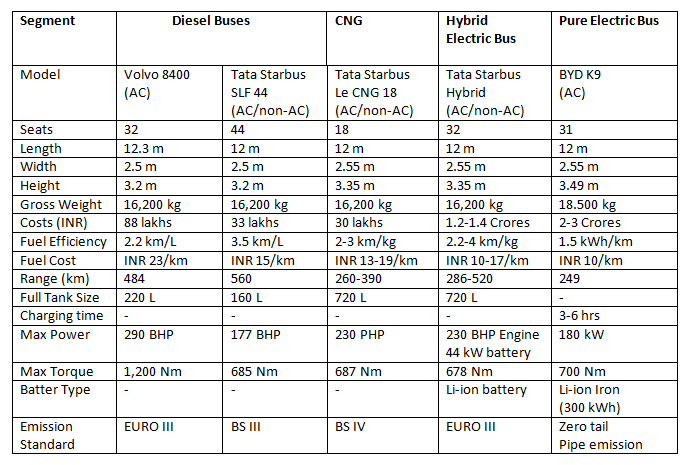
Learn more on various Status & Trends in E-Mobility across: Indian EV Prices | Global EV Market | Indian EV Market | Current status of Indian EV Market | Challenges to Indian E-mobilty | International Startups Takeaways | Indian Startups takeaways |
![]() Know more on how EV Next can assist your business in your strategy for the e-mobility and electric vehicles sectors, Here
Know more on how EV Next can assist your business in your strategy for the e-mobility and electric vehicles sectors, Here
Wish to know everything about India’s EV market from one place? Check out the India EV Expert Guide, an 800 page comprehensive guide to the Indian EV market. Here
Get to know about 1000+ EV innovations from EVI2: Electric Vehicle Innovation Intelligence from EVNext
See also the blog posts:
- Key Indian Battery Makers Plans for EVs – Exide, Amara Raja, HBL, Eveready Strategy for Electric Vehicle Batteries
- Challenges to EV Growth in India – Cost & Performance Challenges for Indian Electric Vehicle Market
- Strategy for Indian Electric Vehicle Growth – Product, Tech, Infra Strategies for EV Market
- India Electric Vehicle Market Strategic Insights & Perspectives from EAI
Comprehensive Inputs on Indian EV Ecosystem
Check out the following sections for comprehensive inputs on Indian EV ecosystem (click on each section for more details)
Check out: EAI Consulting for Electric Mobility – Electric Vehicles, EV Components & EV Charging Infrastructure





 Our specialty focus areas include
Our specialty focus areas include

